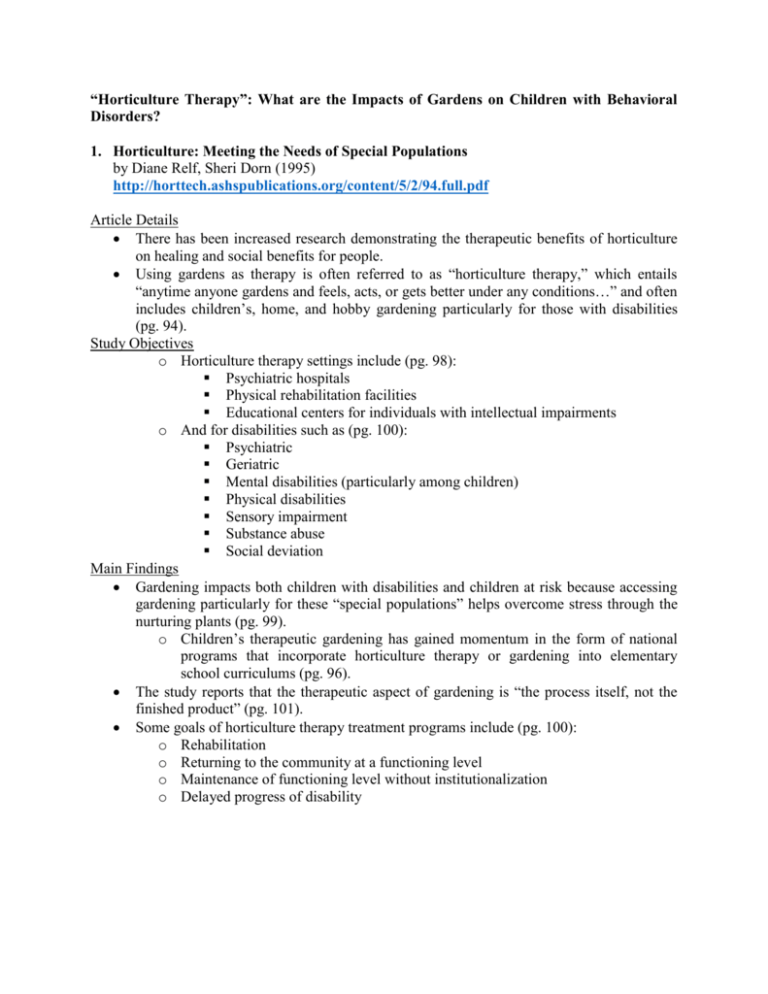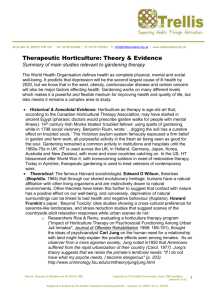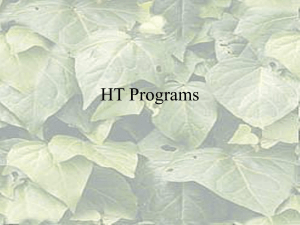Impacts of Gardens on Children with Behavioral Disorders (Text
advertisement

“Horticulture Therapy”: What are the Impacts of Gardens on Children with Behavioral Disorders? 1. Horticulture: Meeting the Needs of Special Populations by Diane Relf, Sheri Dorn (1995) http://horttech.ashspublications.org/content/5/2/94.full.pdf Article Details There has been increased research demonstrating the therapeutic benefits of horticulture on healing and social benefits for people. Using gardens as therapy is often referred to as “horticulture therapy,” which entails “anytime anyone gardens and feels, acts, or gets better under any conditions…” and often includes children’s, home, and hobby gardening particularly for those with disabilities (pg. 94). Study Objectives o Horticulture therapy settings include (pg. 98): Psychiatric hospitals Physical rehabilitation facilities Educational centers for individuals with intellectual impairments o And for disabilities such as (pg. 100): Psychiatric Geriatric Mental disabilities (particularly among children) Physical disabilities Sensory impairment Substance abuse Social deviation Main Findings Gardening impacts both children with disabilities and children at risk because accessing gardening particularly for these “special populations” helps overcome stress through the nurturing plants (pg. 99). o Children’s therapeutic gardening has gained momentum in the form of national programs that incorporate horticulture therapy or gardening into elementary school curriculums (pg. 96). The study reports that the therapeutic aspect of gardening is “the process itself, not the finished product” (pg. 101). Some goals of horticulture therapy treatment programs include (pg. 100): o Rehabilitation o Returning to the community at a functioning level o Maintenance of functioning level without institutionalization o Delayed progress of disability 2. Horticultural Training for Adolescent Special Education Students by Douglas L. Airhart, Thomas Willis, and Pamela Westrick (1987) http://files.eric.ed.gov/fulltext/ED331192.pdf Program Details Horticulture therapy can be used to help those with mental, physical or developmental disabilities and can rehabilitate patients while helping in behavioral and job skill training (pg. 18). The goal of this program was to rehabilitate such individuals to “qualify them for transitional employment” and to improve “behavioral and prevocational skills of adolescent students unable to attend regular high schools” (pg. 17). Students were instructed in greenhouse management, garden tasks and horticultural activities, among interacting with the public and socializing. For example (pg. 19): o Preparing and amending ground beds o Propagating plants o Controlling weeds o Building a yearly compost heap Program Outcomes The study suggests that there are intellectual, social, emotional, and physical benefits that result from garden therapy. This program in particular resulted in participants’ developing certain skills, becoming more self-sufficient, and improving their self-esteem (pg. 20). Main Findings The authors conclude that: “The horticulture industry is beginning to recognize the benefits of hiring persons with disabilities. Horticultural training programs can provide the link between these two professions” (pg. 21). 3. Gardening as therapy for children with behavioral disorders by Marilyn McGinnis (1989) http://www.ncbi.nlm.nih.gov/pubmed/2769590 Program Details The authors first compiled a literature review on the effects of horticulture on hospital patients, suggesting “the usefulness of gardening for other patient populations” like children (pg. 87): o Gardening was used by nurses to produce physical and psychological outcomes for patients. o Rehabilitation literature indicated that this was an area in which horticulture therapy was used more, reporting that “enhanced self-esteem” was one of the most common benefits of such programs. The program was implemented among 24 four-to-ten year old hospitalized children with behavioral disorders including, but not limited to (pg. 88): o Conduct disorders o Moderate mental retardation o Separation anxiety o Attention deficit disorders The children had weekly garden group discussion sessions and gardening tasks (e.g. planting, weeding, harvesting, etc.) (pg. 88). Program Outcomes Garden group discussions often were used to discuss personal problems the children experienced, and included: Feelings about learning new skills Experiences with teamwork Plant reproduction (which led to discussion of parent-child relationships) Grief (discussion inspired by death of a plant) Plant anatomy The authors indicated that the gardening experience extended beyond just the gardening sessions as children would indicate their participation in home-gardening, drawing/writing about gardening, and “maintain[ed] its therapeutic value to them after discharge” (pg. 90). This particular hospital horticulture program demonstrated benefits to children with behavioral disorders in allowing patients to express themselves while also facilitating the nursing staff’s ability to assess their patients and address problems they experienced (pg. 91). Main Findings The authors emphasize the ease at which gardening programs can be implemented because of it is not costly, it does not require extreme expertise, and can even generate produce. They concluded that “the benefits realized in this program imply that gardening is a therapeutic medium that psychiatric nurses can and should exploit in the treatment of children with behavioral disorders” (pg. 91). The results of the study suggest that this type of program can be extended to the school setting to assist as therapy for children with behavioral and emotional disorders.









![Newsletter 26.04.13[1]](http://s3.studylib.net/store/data/006782410_1-da9f3895022a2272f47db633b66536f9-300x300.png)